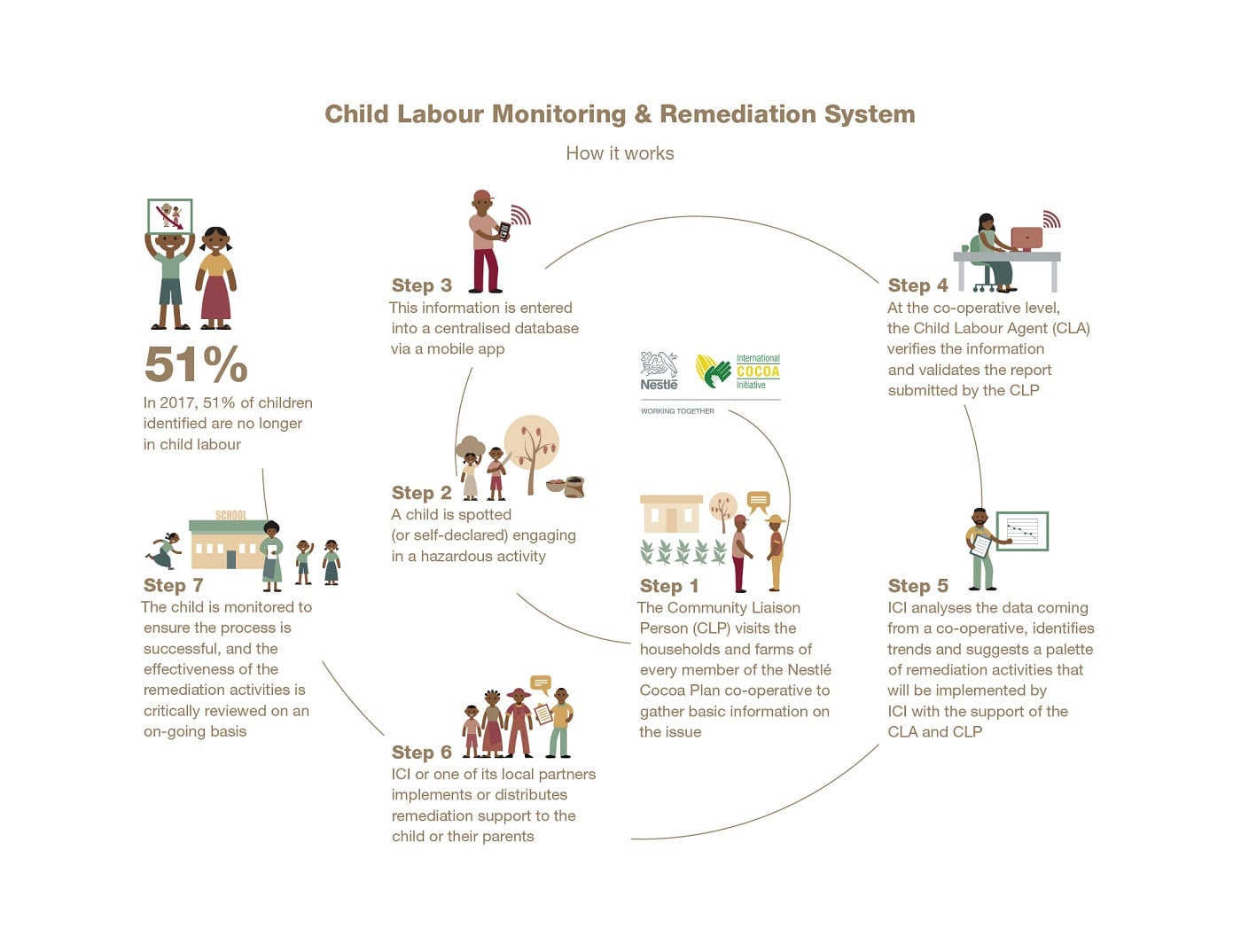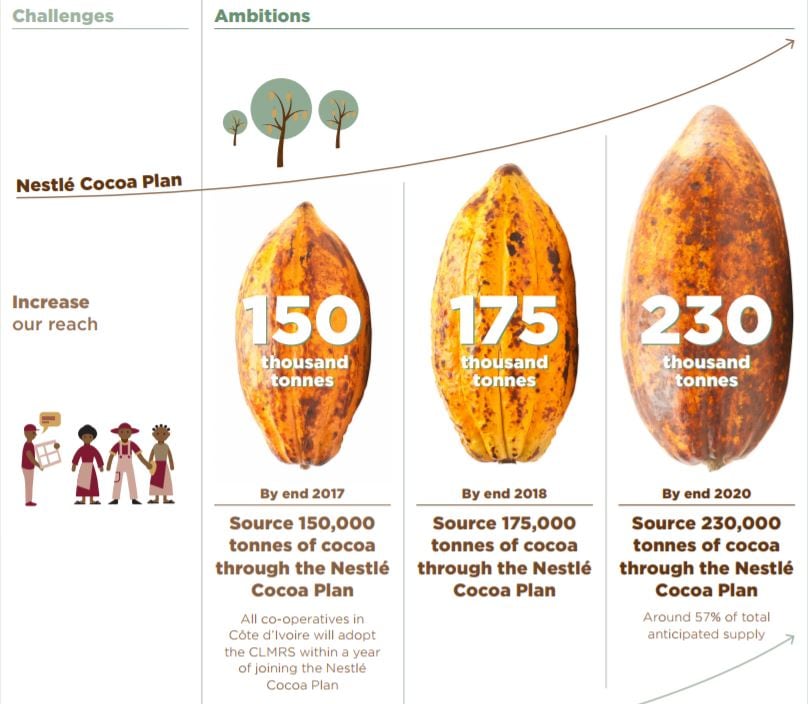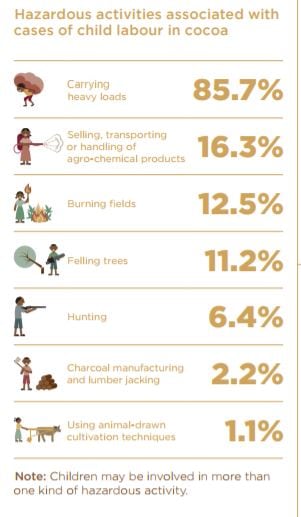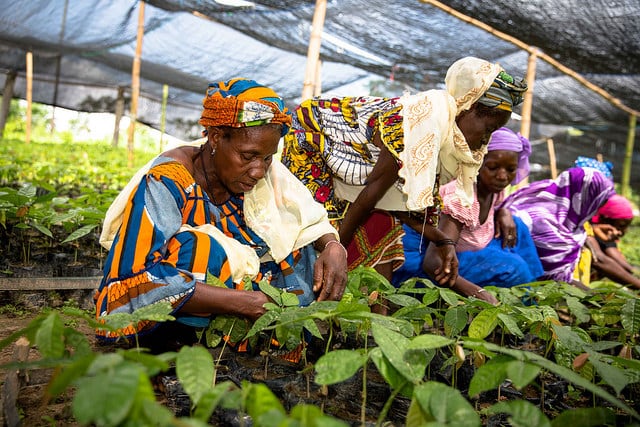The KitKat maker published a report this month claiming a Child Labor Monitoring Remediation System (CLMRS) it has adopted in a portion of its cocoa supply chain in Cote D’Ivoire and Ghana since 2012 reduces incidents of child labor by 51%*.
Nestlé has discovered around 7,000 children engaged in the worst forms of child labor since the CLMRS began, most of whom are now out of cocoa work.
‘A continuous journey’
Speaking to ConfectioneryNews, Christian Frutiger, global head of public affairs at Nestlé, said it will “take time” to scale up the system.
The CLMRS today covers 75 co-operatives and 48,000 farmers, representing roughly 130,000 metric tons (MT) of cocoa supply.
But almost 70% of Nestlé’s cocoa volumes have no CLMRS.
The prevention system relies on around 1,200 community liaison officers, local people who detect incidences of child labor and report back to NGO partner the International Cocoa Initiative (ICI).
ICI deals with incidents on a case-by-case basis for example by assisting with a birth certificate to enable a child to attend school.

57% from the Nestlé Cocoa Plan by 2020
The CLMRS is embedded into Nestlé sustainability program The Nestlé Cocoa Plan, which today covers a third of the firm’s total annual supply of 400,000 MT.
"Total 100% [Covered by a CLMRS] will probably never quite be possible, but it's a continuous journey. We are working to scaling up to 50% and continuing the journey towards the 100%,” said Frutiger.

Nestlé this month pledged to source 57% of volumes from its Cocoa Plan by 2020, equivalent to around 230,000 MT.
Scaling up
Today, two thirds of Nestlé’s cocoa are not part its Cocoa Plan and only 33% of its volumes have the CLMRS in place.
Asked if Nestlé should continue to source non-Cocoa plan volumes where no CLMRS exists, Fruiter said: "I think Nestlé is doing everything possible…This will take time and we are scaling this up as fast as we can. We need more partners in this, so it is important this is a collective effort."
He added Nestlé would prioritize areas with the highest child labor risk, while rolling out its CLMRS more widely in Ghana and expanding in Côte D’Ivoire.
Not reliant on cooperatives
Nestlé purchases volumes outside its Cocoa Plan mainly on the global market from traders and intermediaries.
Volumes in its Cocoa Plan are all from cooperatives, which are either Fairtrade or UTZ certified.
The International CoCoa Farmers Organization (ICCFO) estimates 90% of global cocoa is grown by smallholder outside of cooperatives.
Frutiger said the CLMRS was not reliant on cooperative structures.
"The CLMRS is actually quite adaptable because it’s based on community liaison people. The moment you have those in the community whether there are cooperatives or not, you can achieve coverage,” he said.

CLMRS: Shortening supply chains
In 2011, Nestlé commissioned the Fair Labor Association to review its cocoa supply chain and later developed the CLMRS based on its recommendations.
Nestlé previously relied mainly on local governments to tackle child labor in cocoa communities.
Frutiger said: “We may not have fully understood the full complexity of the issue of child labor” before the report was commissioned.
“We do not own any farms, so the first thing we had to do was actually shorten the supply chain. So we are basically down to the farmer who works with a cooperative and an intermediary, a supplier to Nestlé,” continued the public affairs chief.
Earlier this year, a district court in California dismissed a 12-year lawsuit accusing Nestlé, ADM and Cargill of aiding and abetting child slavery in West Africa.
Heavy loads
The majority of illegal child laborers discovered in Nestlé’s CLMRS are children helping on family farms, according to a February 2017 analysis of 39,215 children.
Around 86% of cases involve carry heavy loads such as cocoa beans, water or firewood.
Selling, transporting or handling agro-chemical products was the second most common illegal activity, accounting for 16.3% of total cases.
Frutiger said Nestlé’s remediation efforts mean the majority of children are not found in child labor months or years later.
"There is never a 100% guarantee that there is no child labor...there may be cases of child labor. Child labor is a phenomenon of poverty and that phenomenon needs a multi-pronged approach,” he said.

Reporting incomes
How committed is Nestlé to addressing poverty?
"We have system called the Rural Development Framework, which we have rolled out in Côte D'Ivoire, Ghana and many other counties, which looks at the actual quality of life...its a composition of income, access to healthcare, education, child labor, gender, access to water and sanitation,” said Frutiger.
He said Nestlé had baseline numbers for these elements including income.
But the Swiss firm has yet to publically report average incomes for farmers in its Cocoa Plan.
"It will be publically reported. We've established a baseline and then we go into measuring what the impact is. This again takes a little bit of time,” said Frutiger.
The Nestlé Cocoa Plan began eight years ago in 2009.
Frutiger added: "We are looking at livelihoods not only just income, so we will report on those when the full numbers are available and when we have the full picture."
GES: ‘Investors expect more’
A report published in June by investment advisor GES said: “Even though the issue of child labor in the cocoa supply chain has been publicly known for almost two decades, there are still two million children working on cocoa farms in Côte D’Ivoire and Ghana. Investors expect more.” The report set out investor expectations for chocolate companies’ sustainability programs, including to:
- Demonstrate progress towards a living income for farmers in Côte D'Ivoire and Ghana, by reporting on the impact of farmer programs and other initiatives on farmer income, and;
- Reporting to what extent current income levels match a living income for cocoa-growing farmers in the two countries.
Efforts to combat extreme poverty
Frutiger claimed Nestlé was looking to improve cocoa farmer livelihoods mainly via four methods:
- Productivity - distributing higher yielding plants
- Premiums - Paying premiums for good farming practices
- Income diversification - e.g. via other crops such as cassava
- Next generation - Attracting the younger generation to cocoa farming
Nestlé told us it paid a CHF 180 ($184) premium per MT to farmers part of its Cocoa Plan in Côte D’Ivoire in 2016 – this includes the premium required by Fairtrade and UTZ.
Nestlé also has built 42 schools where they did not exist in communities and supports with other expenses preventing attendance such as school uniforms or transport.
Who bears the cost?
But who bears the cost of the CLMRS - Nestlé, retailers or consumers?
"...It comes as part of the cost of doing business and it has its impact of course on the end product," said Frutiger.
Nestlé spent CHF 5.5m ($5.6m) on tackling child labor in 2016, covering the CLMRS and school building projects.
Two million children
A Tulane University study found 2.03m children in hazardous cocoa work in Ghana and Côte D’Ivoire during the 2013/14 cocoa year, up 18% from 2008/09.
Asked how the figures would progress, Frutiger said: "I sincerely hope they will come down - definitely the numbers in our own Cocoa Plan cooperatives have come down significantly and the experience shows that if it’s done right, children return to school or go to school and don’t find themselves in child labor anymore."
*A Nestlé evaluation in 2017 (with a sample of 1,056 children) in co-operatives where the CLMRS was set-up between 2013 and 2015 indicates 51% of the children engaged in child labour from this sample were no longer doing so in July 2017.
